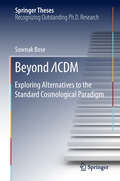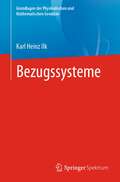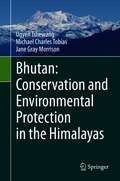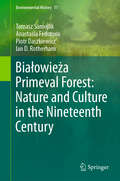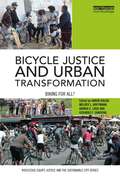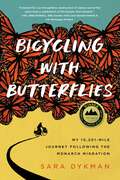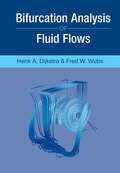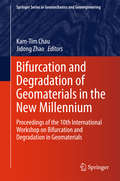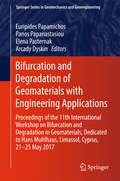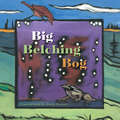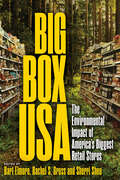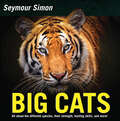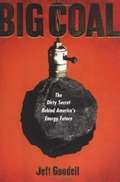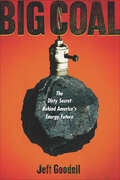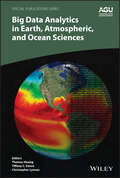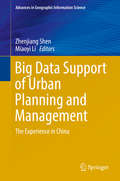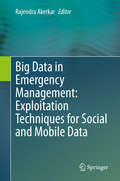- Table View
- List View
Beyond ΛCDM: Exploring Alternatives To The Standard Cosmological Paradigm (Springer Theses)
by Sownak BoseThis book employs computer simulations of ‘artificial’ Universes to investigate the properties of two popular alternatives to the standard candidates for dark matter (DM) and dark energy (DE). It confronts the predictions of theoretical models with observations using a sophisticated semi-analytic model of galaxy formation. Understanding the nature of dark matter (DM) and dark energy (DE) are two of the most central problems in modern cosmology. While their important role in the evolution of the Universe has been well established—namely, that DM serves as the building blocks of galaxies, and that DE accelerates the expansion of the Universe—their true nature remains elusive. In the first half, the authors consider ‘sterile neutrino’ DM, motivated by recent claims that these particles may have finally been detected. Using sophisticated models of galaxy formation, the authors find that future observations of the high redshift Universe and faint dwarf galaxies in the Local Group can place strong constraints on the sterile neutrino scenario. In the second half, the authors propose and test novel numerical algorithms for simulating Universes with a ‘modified’ theory of gravity, as an alternative explanation to accelerated expansion. The authors’ techniques improve the efficiency of these simulations by more than a factor of 20 compared to previous methods, inviting the readers into a new era for precision cosmological tests of gravity.
Bezugssysteme (Grundlagen der Physikalischen und Mathematischen Geodäsie)
by Karl Heinz IlkDieses Lehrbuch aus der Reihe „Grundlagen der Physikalischen und Mathematischen Geodäsie“ zeigt, warum Bezugssysteme und Bezugsrahmen in der Erdmessung eine fundamentale Rolle spielen. Der Autor erläutert den Newtonschen Raum-Zeit-Begriff und gibt eine Einführung in das Einsteinsche Raum-Zeit-Konzept. Wichtige Beziehungen für die Translation der Erde im Sonnensystem werden präsentiert, und es wird ausführlich die Mechanik der Rotation der Erde im Falle drehmomentfreier Bewegungen sowie unter dem Einfluss eines luni-solaren Drehmomentes behandelt. Neben diesen grundlegenden Aspekten werden die Begriffe Ekliptik- und Äquatorsystem als raumfeste Bezugssysteme eingeführt und die Transformationen zwischen den verschiedenen Bezugssystemen bzw. zwischen den verschiedenen Bezugsrahmen behandelt. Eine Zusammenstellung verschiedener Zeitsysteme rundet das Werk ab.
Bhugol Vikasat Bhartiyanche Yogdan First Semester FYBA New NEP Syllabus - RTMNU: भूगोल विकासात भारतीयांचे योगदान पहिले सत्र एफ.वाय.बी.ए. नवीन एन.इ.पी. अभ्यासक्रम - राष्ट्रसंत तुकडोजी महाराज नागपूर विद्यापीठ
by Dr Yogendra S. Nagarale Dr Ankush N. Barmateभूगोल विकासात भारतीयांचे योगदान हे पुस्तक भारतीय विद्वानांनी भूगोलाच्या क्षेत्रात केलेल्या ऐतिहासिक आणि शैक्षणिक योगदानाची सखोल चर्चा करते. भूगोल हा विषय केवळ नकाशे आणि स्थळसंख्या यापुरता मर्यादित नसून त्याचा संबंध मानवी संस्कृती, पर्यावरण, संसाधने आणि ऐतिहासिक प्रवास यांच्याशी आहे. या पुस्तकात भारतीय खगोलशास्त्र, नकाशाशास्त्र, पर्यावरणीय अभ्यास आणि भौगोलिक संशोधनाची प्राचीन तसेच आधुनिक कालखंडातील भूमिका स्पष्ट केली आहे. वेद-उपनिषदांपासून आर्यभट्ट, वराहमिहिर आणि भास्कराचार्य यांच्या कार्यांपर्यंत भारतीय शास्त्रज्ञांनी भूगोलाच्या अभ्यासात दिलेले योगदान यात अधोरेखित केले आहे. राष्ट्रीय शैक्षणिक धोरण (NEP 2020) च्या अनुषंगाने हे पुस्तक विद्यार्थ्यांना भारतीय दृष्टिकोनातून भूगोल शिकण्यास मदत करते आणि त्यांना भारतीय परंपरांचा अभिमान बाळगण्यास प्रेरित करते. तसेच, भारतीय भूगोलशास्त्राचा आधुनिक अभ्यास आणि संशोधनाचे विविध पैलू यात समाविष्ट आहेत.
Bhugol class 10 - Maharashtra Board: भूगोल १०वीं कक्षा - महाराष्ट्र बोर्ड
by Maharashtra Rajya Pathyapustak Nirmiti Va Abhysakram Sanshodhan Mandal Puneयह पुस्तक दसवीं कक्षा के छात्रों को भूगोल की गहन समझ प्रदान करती है, जिसमें प्राकृतिक एवं मानवीय भूगोल के महत्वपूर्ण विषयों को शामिल किया गया है। इसमें पृथ्वी की संरचना, जलवायु परिवर्तन, प्राकृतिक आपदाएँ, जनसंख्या वितरण, संसाधनों का सतत उपयोग, उद्योग, परिवहन और संचार जैसे विषयों को विस्तार से समझाया गया है। पुस्तक में भारत और ब्राजील की भौगोलिक विशेषताओं की तुलना भी की गई है, जिससे छात्रों को विभिन्न भौगोलिक अवधारणाओं का तुलनात्मक अध्ययन करने का अवसर मिलता है। इसमें भारतीय संविधान के अनुच्छेद 51(A) के अंतर्गत नागरिकों के कर्तव्यों पर भी प्रकाश डाला गया है, जिसमें पर्यावरण संरक्षण, वैज्ञानिक दृष्टिकोण अपनाने, और राष्ट्रीय एकता बनाए रखने जैसी जिम्मेदारियाँ शामिल हैं। इसके अलावा, पुस्तक में मानचित्र अध्ययन, सांख्यिकीय डेटा विश्लेषण, क्षेत्र-अध्ययन, और व्यावहारिक परियोजनाओं पर भी ध्यान दिया गया है। यह पाठ्यपुस्तक न केवल छात्रों को परीक्षा की तैयारी में मदद करती है, बल्कि उन्हें भूगोल के व्यावहारिक उपयोग और सतत विकास की दिशा में सोचने के लिए प्रेरित करती है।
Bhugol class 6 - Maharashtra Board: भूगोल ६वीं कक्षा - महाराष्ट्र बोर्ड
by Maharashtra Rajya Pathyapustak Nirmiti Va Abhysakram Sanshodhan Mandal Puneयह पुस्तक छठी कक्षा के छात्रों के लिए भूगोल विषय का मूलभूत परिचय प्रदान करती है। इसमें पृथ्वी की संरचना, उसके विभिन्न पहलू, अक्षांश-देशांतर रेखाएँ, जलवायु, महासागर, चट्टानें, प्राकृतिक संसाधन, ऊर्जा स्रोत और मानवीय व्यवसायों का अध्ययन किया गया है। पुस्तक छात्रों को पृथ्वी के भौगोलिक स्वरूप, उसके मानचित्र, मौसम परिवर्तन, तापमान वितरण, महासागरों के महत्त्व और उनके प्रदूषण से संबंधित जानकारी प्रदान करती है। इसके अलावा, यह संसाधनों के विवेकपूर्ण उपयोग और सतत विकास पर जोर देती है। विद्यार्थियों को क्षेत्रीय अध्ययन, मानचित्र पढ़ने की तकनीक, स्थानों की पहचान और पर्यावरण संरक्षण के प्रति जागरूक किया जाता है। इसमें वैज्ञानिक दृष्टिकोण, सामाजिक समरसता, और प्राकृतिक संसाधनों के संरक्षण पर बल दिया गया है। भूगोल को सरल और रोचक बनाने के लिए पुस्तक में चित्र, मानचित्र और गतिविधियाँ शामिल की गई हैं, जिससे छात्र व्यावहारिक ज्ञान अर्जित कर सकें और इसे दैनिक जीवन में लागू कर सकें।
Bhugol class 7 - Maharashtra Board: भूगोल ७वीं कक्षा - महाराष्ट्र बोर्ड
by Maharashtra Rajya Pathyapustak Nirmiti Va Abhysakram Sanshodhan Mandal Puneयह पुस्तक सातवीं कक्षा के विद्यार्थियों के लिए भूगोल विषय की मूलभूत और महत्वपूर्ण अवधारणाओं को सरल और रोचक तरीके से प्रस्तुत करती है। इसमें पृथ्वी की भौगोलिक संरचना, जलवायु परिवर्तन, ऋतुचक्र, सूर्य, चंद्रमा और पृथ्वी के पारस्परिक संबंध, ज्वार-भाटा, वायुदाब, हवाओं की दिशा, प्राकृतिक प्रदेश, मिट्टी, कृषि और मानवीय बस्तियों से संबंधित विषयों को शामिल किया गया है। पुस्तक में भारत के संविधान के अनुच्छेद 51(A) के तहत नागरिकों के मूलभूत कर्तव्यों पर भी प्रकाश डाला गया है, जिसमें पर्यावरण संरक्षण, वैज्ञानिक दृष्टिकोण अपनाने और राष्ट्रीय एकता बनाए रखने की बात कही गई है। मानचित्र, चित्र, तालिकाएँ और गतिविधियों के माध्यम से विद्यार्थियों को अवधारणाएँ समझने में सहायता मिलती है। इसके अलावा, छात्रों को पर्यावरण संरक्षण, संसाधनों के विवेकपूर्ण उपयोग और सतत विकास की ओर प्रेरित करने के लिए व्यावहारिक उदाहरण दिए गए हैं। यह पुस्तक भूगोल के प्रति जिज्ञासा बढ़ाने और छात्रों को विषय का व्यावहारिक ज्ञान प्रदान करने में सहायक सिद्ध होती है।
Bhugol class 8 - Maharashtra Board: भूगोल ८वीं कक्षा - महाराष्ट्र बोर्ड
by Maharashtra Rajya Pathyapustak Nirmiti Va Abhysakram Sanshodhan Mandal Puneयह पुस्तक विद्यार्थियों को भूगोल की गहन समझ प्रदान करती है, जिसमें पृथ्वी की आंतरिक संरचना, स्थानीय एवं मानक समय, महासागरों की धाराएँ, जलवायु परिवर्तन, भूमि उपयोग, जनसंख्या वितरण और औद्योगिक विकास जैसे विषय शामिल हैं। इसमें भारत के मानक समय (IST), विभिन्न प्राकृतिक संसाधनों के उपयोग और पर्यावरणीय संतुलन पर विशेष ध्यान दिया गया है। इसके अलावा, भारत के संविधान के अनुच्छेद 51(A) के तहत नागरिकों के मौलिक कर्तव्यों, जैसे पर्यावरण संरक्षण, वैज्ञानिक दृष्टिकोण अपनाने और राष्ट्र की एकता बनाए रखने पर भी प्रकाश डाला गया है। पुस्तक में मानचित्र, चित्र, गतिविधियाँ और अध्ययन-अध्यापन के डिजिटल संसाधनों को भी जोड़ा गया है। यह छात्रों को भूगोल विषय की व्यावहारिक समझ विकसित करने में मदद करती है और उन्हें सतत विकास की दिशा में सोचने के लिए प्रेरित करती है।
Bhutan: Conservation and Environmental Protection in the Himalayas
by Michael Charles Tobias Jane Gray Morrison Ugyen TshewangLocated in the heart of the Eastern Himalayas, Bhutan practices the philosophy of Gross National Happiness (“GNH”) that embraces environmental conservation as one of the main building blocks for its sustainable development goals. Bhutan’s conservation strategies and success are largely driven by the strong political will and visionary leadership of His Majesty the King of Bhutan The nation’s Buddhist perspectives regarding a deep and abiding respect for nature; and the strategic enforcement of a wide-ranging stringent set of internal regulations and controls have helped ensure ecological gold standards in Bhutan. Moreover, the country is an active member of the international conservation community by fulfilling its implementation of various Multilateral Environment Agreements. While it emerged into the 21st century as one of the 36 global terrestrial “hotspots” in biological diversity conservation ranks, Bhutan’s sheer commitment with more than 51% of its territory being managed under the explicit status of a protected area network, and more than 70% of the land under forest cover, represents Bhutan’s exemplary dedication to protect the planet despite its smallness in size and economy, and the biological fragility exemplified by its hotspot situation. In the face of imminent severe threats of global warming, Bhutan nonetheless exemplifies the truth that “a small country with a big conservation commitment” can make an enormous contribution to the global community.At the regional level, Bhutan is intent upon protecting the Water Towers of Asia (that glacial expanse of the Himalayas) which is a critical resource bulwark for about one-fifth of the global population downstream in South Asia. Such protections invariably help mitigate climate change by acting as a nation-wide carbon sink through its carbon neutral policies. In short, Bhutan has long represented one of the world’s foremost national guardians of biodiversity conservation, ecological good governance, and societal sustainability at a period when the world has entered the Anthropocene – an epoch of mass extinctions.We envision this publication to be ecologically and ethically provocative and revealing for the concerned scientific communities, and governments. Through an extensive review of the scientific and anthropological literature, as well as the research team's own data, the Author's have set forth timely recommendations for conservation policies, strategies and actions. This book provides technical and deeply considered assessments of the state of Bhutan’s environment, its multiple, human-induced stressors and pressures; as well as extremely sound, practical techniques that would address conservation strategies in the Himalayas and, by implication, worldwide.
Białowieża Primeval Forest: Nature and Culture in the Nineteenth Century (Environmental History #11)
by Tomasz Samojlik Ian D. Rotherham Anastasia Fedotova Piotr DaszkiewiczUnderstanding the current state and dynamics of any forest is extremely difficult - if not impossible - without recognizing its history. Białowieża Primeval Forest (BPF), located on the border between Poland and Belarus, is one of the best preserved European lowland forests and a subject of myriads of works focusing on countless aspects of its biology, ecology, management. BPF was protected for centuries (15th-18th century) as a game reserve of Polish kings and Lithuanian grand dukes. Being, at that time, a part of the Grand Duchy of Lithuania, BPF was subject to long-lasting traditional, multi-functional utilisation characteristic for this part of Europe, including haymaking on forest meadows, traditional bee-keeping and fishing in rivers flowing through forest. This traditional model of management came to an abrupt end due to political change in 1795, when Poland and Grand Duchy of Lithuania ceased to exist in effect of partitioning by neighbouring countries, and the territory of BPF was taken over by the Russian Empire. The new Russian administration, influenced by the German trends in forestry, attempted at introducing the new, science-based forestry model in the BPF throughout the 19th century. The entire 19th century in the history of BPF is a story of struggle between new trends and concepts brought and implemented by new rulers of the land, and the traditional perception of the forest and forest uses, culturally rooted in this area and originating from mediaeval (or older) practices.The book will show the historical background and the outcome of this struggle: the forest’s history in the long 19th century focusing on tracking all cultural imprints, both material (artificial landscapes, introduced alien species, human-induced processes) and immaterial (traditional knowledge of forest and use of forest resources, the political and cultural significance of the forest) that shaped the forest’s current state and picture. Our book will deliver a picture of a crucial moment in forest history, relevant not only to the Central Europe, but to the continent in general. Moment of transition between a royal hunting ground, traditional type of use widespread throughout Europe, to a modern, managed forest. Looking at main obstacles in the management shift, the essential difference in perceptions of the forest and goods it provides in both modes of management, and the implications of the management change for the state of BPF in the long 19th century could help in better understanding the changes that European forests underwent in general.
Bicycle Justice and Urban Transformation: Biking for all? (Routledge Equity, Justice and the Sustainable City series)
by Aaron Golub Melody L. Hoffmann Adonia E. Lugo Gerardo F. SandovalAs bicycle commuting grows in the United States, the profile of the white, middle-class cyclist has emerged. This stereotype evolves just as investments in cycling play an increasingly important role in neighborhood transformations. However, despite stereotypes, the cycling public is actually quite diverse, with the greatest share falling into the lowest income categories. Bicycle Justice and Urban Transformation demonstrates that for those with privilege, bicycling can be liberatory, a lifestyle choice, whereas for those surviving at the margins, cycling is not a choice, but an often oppressive necessity. Ignoring these "invisible" cyclists skews bicycle improvements towards those with choices. This book argues that it is vital to contextualize bicycling within a broader social justice framework if investments are to serve all street users equitably. "Bicycle justice" is an inclusionary social movement based on furthering material equity and the recognition that qualitative differences matter. This book illustrates equitable bicycle advocacy, policy and planning. In synthesizing the projects of critical cultural studies, transportation justice and planning, the book reveals the relevance of social justice to public and community-driven investments in cycling. This book will interest professionals, advocates, academics and students in the fields of transportation planning, urban planning, community development, urban geography, sociology and policy.
Bicycling with Butterflies: My 10,201-Mile Journey Following the Monarch Migration
by Sara Dykman&“What a wonderful idea for an adventure! Absolutely inspired, timely, and important.&” —Alistair Humphreys, National Geographic Adventurer of the Year and author of The Doorstep Mile and Around the World by Bike Outdoor educator and field researcher Sara Dykman made history when she became the first person to bicycle alongside monarch butterflies on their storied annual migration—a round-trip adventure that included three countries and more than 10,000 miles. Equally remarkable, she did it solo, on a bike cobbled together from used parts. Her panniers were recycled buckets. In Bicycling with Butterflies, Dykman recounts her incredible journey and the dramatic ups and downs of the nearly nine-month odyssey. We&’re beside her as she navigates unmapped roads in foreign countries, checks roadside milkweed for monarch eggs, and shares her passion with eager schoolchildren, skeptical bar patrons, and unimpressed border officials. We also meet some of the ardent monarch stewards who supported her efforts, from citizen scientists and researchers to farmers and high-rise city dwellers. With both humor and humility, Dykman offers a compelling story, confirming the urgency of saving the threatened monarch migration—and the other threatened systems of nature that affect the survival of us all.
Bifurcation Analysis of Fluid Flows
by Henk A. Dijkstra Fred W. WubsA better understanding of the mechanisms leading a fluid system to exhibit turbulent behavior is one of the grand challenges of the physical and mathematical sciences. Over the last few decades, numerical bifurcation methods have been extended and applied to a number of flow problems to identify critical conditions for fluid instabilities to occur. This book provides a state-of-the-art account of these numerical methods, with much attention to modern linear systems solvers and generalized eigenvalue solvers. These methods also have a broad applicability in industrial, environmental and astrophysical flows. The book is a must-have reference for anyone working in scientific fields where fluid flow instabilities play a role. Exercises at the end of each chapter and Python code for the bifurcation analysis of canonical fluid flow problems provide practice material to get to grips with the methods and concepts presented in the book.
Bifurcation and Degradation of Geomaterials in the New Millennium: Proceedings of the 10th International Workshop on Bifurcation and Degradation in Geomaterials (Springer Series in Geomechanics and Geoengineering)
by Kam-Tim Chau Jidong ZhaoThis book contains contributions to the 10th International Workshop on Bifurcation and Degradation in Geomaterials held in Hong Kong, May 28-30, 2014. This event marks the silver Jubilee anniversary of an international conference series dedicated to the research on localization, instability, degradation and failure of geomaterials since 1988 when its first workshop was organized in Germany. This volume of book collects the latest progresses and state-of-the-art research from top researchers around the world, and covers topics including multiscale modeling, experimental characterization and theoretical analysis of various instability and degradation phenomena in geomaterials as well as their relevance to contemporary issues in engineering practice. This book can be used as a useful reference for research students, academics and practicing engineers who are interested in the instability and degradation problems in geomechanics and geotechnical engineering.
Bifurcation and Degradation of Geomaterials with Engineering Applications: Proceedings of the 11th International Workshop on Bifurcation and Degradation in Geomaterials dedicated to Hans Muhlhaus, Limassol, Cyprus, 21-25 May 2017 (Springer Series in Geomechanics and Geoengineering)
by Euripides Papamichos Panos Papanastasiou Elena Pasternak Arcady DyskinThis book contains the scientific contributions to the 11th International Workshop on Bifurcation and Degradation in Geomaterials (IWBDG) held in Limassol-Cyprus, May 21-25, 2017. The IWBDG series have grown in size and scope, since their inception 30 years ago in Germany, covering more and wider areas of geomaterials and geomechanics research including modern trends. The papers cover a wide range of topics including advances in instabilities, localized and diffuse failure, micromechanical, multiscale phenomena, multiphysics modeling and other related topics. This volume gathers a series of manuscript by brilliant international scholars who work on modern recent advances in experimental, theoretical and numerical methods. The theoretical and applied mechanics are linked successfully with engineering applications in traditional and in emerging fields, such as geomechanics for the energy and the environment. The quality of the contributed papers has benefited from the peer review process by expert referees. This book can be used as a useful reference for research students, academics and practicing engineers who are interested in the instability and degradation problems in geomaterials, geomechanics, geotechnical engineering and other related applications.
Big Basin Redwood Forest: California's Oldest State Park (Landmarks)
by Traci BlissThe epic saga of Big Basin began in the late 1800s, when the surrounding communities saw their once "inexhaustible" redwood forests vanishing. Expanding railways demanded timber as they crisscrossed the nation, but the more redwoods that fell to the woodman's axe, the greater the effects on the local climate. California's groundbreaking environmental movement attracted individuals from every walk of life. From the adopted son of a robber baron to a bohemian woman winemaker to a Jesuit priest, resilient campaigners produced an unparalleled model of citizen action. Join author Traci Bliss as she reveals the untold story of a herculean effort to preserve the ancient redwoods for future generations.
Big Belching Bog
by Phyllis RootCold, wet, and acidic, bogs appear to be extremely hostile to life, yet numerous plants and animals have adapted in fascinating ways in order to survive there. In Big Belching Bog, Phyllis Root lets us in on the secrets of the mysterious bog, describing such special inhabitants as plants that eat insects, bog lemmings, and frogs that stay frozen through the winter and thaw out in the spring. But what's that coming up from the bottom of the bog? The biggest bog secret of all, we learn, is the remarkable process of methane gas belching out of the bog. The gas is created by decaying peat moss and forms a bulge in the surface of the moss six inches or taller before breaking through. Does this "belch" make a sound? No one knows, says Root, because no one has ever heard it. In fact, bogs are known as some of the quietest places on earth. Maybe you will be the first to hear the big bog belch! Illustrated by renowned woodcut artist Betsy Bowen, Big Belching Bog also contains a section of bog facts, including more information about the plants and animals mentioned in the book as well as tips for visiting a bog. Big Belching Bog will stir the imagination of young readers and teach them about the landscape and environment of these mysterious and, ahem, gassy places.
Big Box USA: The Environmental Impact of America’s Biggest Retail Stores (Path to Open)
by Rachel S. Gross Bart Elmore Sherri SheuBig Box USA presents a new look at how the big box retail store has dramatically reshaped the US economy and its ecosystems in the last half century. From the rural South to the frigid North, from inside stores to ecologies far beyond, this book examines the relationships that make up one of the most visible features of late twentieth-century and early twenty-first-century American life. The rise of big box retail since the 1960s has transformed environments on both local and global scales. Almost everyone has explored the aisles of big box stores. The allure of “everyday low prices” and brightly colored products of every kind connect shoppers with a global marketplace. Contributors join a growing conversation between business and environmental history, addressing the ways American retail institutions have affected physical and cultural ecologies around the world. Essays on Walmart, Target, Cabela’s, REI, and Bass Pro Shops assess the “bigness” of these superstores from “smokestacks to coat racks” and contend that their ecological impacts are not limited to the footprints of parking lots and manufacturing but also play a didactic role in educating consumers about their relationships with the environment. A model for historians seeking to bring business and environmental histories together in their analyses of merchant capital’s role in the landscapes of everyday life and how it has remade human relationships with nature, Big Box USA is a must-read for students and scholars of the environment, business, sustainability, retail professionals, and a general audience.
Big Cats: Revised Edition
by Seymour SimonIn this completely updated edition of Big Cats, award-winning writer Seymour Simon celebrates the grace and power of lions, tigers, leopards, jaguars, cheetahs, pumas, and snow leopards. Readers will learn all about how they hunt, care for their young, and rest in their varied natural habitats. This nonfiction picture book is packed with information and beautiful color photographs. Cat fans and kids ages 6 to 10 looking for facts, whether for a report or just for fun, will find much to like in Big Cats.This updated edition includes:Author’s noteStunning full-color photographsGlossaryIndexAdditional reading sourcesSupports the Common Core Learning Standards, Next Generation Science Standards, and the Science, Technology, Engineering, and Math (STEM) standards.
Big Coal: The Dirty Secret Behind America's Energy Future
by Jeff GoodellPresident Bush has said coal is America's "economic destiny." Despite a century-long legacy that has claimed millions of lives and ravaged the environment, why has coal become hot again? Few of us realize that coal already supplies more than half the energy needed to power our iPods, laptops, lightsanything we use that consumes electricity. Every time we flip on a switch, we burn a lump of coal. Our desire to find a homegrown alternative to Mideast oil, the rising cost of oil and natural gas, and the fossil fuelfriendly mood in Washington will soon push our coal consumption through the roof. Because we have failed to develop alternative energy sources, coal has become the default fuel for the twenty-first century. In the tradition of Rachel Carson and Eric Schlosser, the veteran journalist Jeff Goodell examines the faulty assumptions underlying coal's revival and shatters the myth of cheap coal energy. In a compelling blend of hard-hitting investigative reporting, history, and business analysis, Big Coal illuminates the stark economic imperatives America faces and the collusion of business and politics that has already set us on the dangerous course. Filled with troubling environmental and health revelations, Big Coal shows us that our shiny white iPod economy is propped up by dirty black rocks.
Big Coal: The Dirty Secret Behind America's Energy Future
by Jeff GoodellNew York Times–Bestselling Author:“Should be ready by anyone who owns a microwave, or an iPod, or a table lamp, which is to say everyone.” —Elizabeth Kolbert, Pulitzer Prize–winning author of The Sixth ExtinctionA Kirkus Reviews Best Book of the YearCoal is still a significant source of power in the United States—and coal mining is still a deadly and environmentally destructive industry. Much of the carbon dioxide released into the atmosphere each year comes from coal-fired power plants, and in recent decades air pollution from coal plants has killed more than half a million Americans. In this eye-opening call to action, Jeff Goodell explains the costs and consequences of America’s addiction to coal and discusses how we can kick the habit.“[A] compelling indictment . . . powerful.” —The New York Times Book Review“Goodell’s description of the mining-related deaths, the widespread health consequences of burning coal and the impact on our planet’s increasingly fragile ecosystem make for compelling reading, but . . . are not what lift this book out of the ordinary. That distinction belongs to Goodell’s fieldwork, which takes him to Atlanta, West Virginia, Wyoming, China and beyond.” —Publishers Weekly (starred review)“Goodell does a first-rate job of balancing environmental concerns with interviews from the human faces associated with ‘Big Coal’.” —Library Journal
Big Data Analytics in Earth, Atmospheric, and Ocean Sciences (Special Publications)
by Thomas Huang Tiffany C. Vance Christopher LynnesApplying tools for data analysis to the rapidly increasing volume of data about the Earth An ever-increasing volume of Earth data is being gathered. These data are &“big&” not only in size but also in their complexity, different formats, and varied scientific disciplines. As such, big data are disrupting traditional research. New methods and platforms, such as the cloud, are tackling these new challenges. Big Data Analytics in Earth, Atmospheric, and Ocean Sciences explores new tools for the analysis and display of the rapidly increasing volume of data about the Earth. Volume highlights include: An introduction to the breadth of big earth data analytics Architectures developed to support big earth data analytics Different analysis and statistical methods for big earth data Current applications of analytics to Earth science data Challenges to fully implementing big data analytics The American Geophysical Union promotes discovery in Earth and space science for the benefit of humanity. Its publications disseminate scientific knowledge and provide resources for researchers, students, and professionals.
Big Data Support of Urban Planning and Management: The Experience in China (Advances in Geographic Information Science)
by Zhenjiang Shen Miaoyi LiIn the era of big data, this book explores the new challenges of urban-rural planning and management from a practical perspective based on a multidisciplinary project. Researchers as contributors to this book have accomplished their projects by using big data and relevant data mining technologies for investigating the possibilities of big data, such as that obtained through cell phones, social network systems and smart cards instead of conventional survey data for urban planning support. This book showcases active researchers who share their experiences and ideas on human mobility, accessibility and recognition of places, connectivity of transportation and urban structure in order to provide effective analytic and forecasting tools for smart city planning and design solutions in China.
Big Data for Remote Sensing: Digital Earth And Smart Earth
by Nilanjan Dey Chintan Bhatt Amira S. AshourThis book thoroughly covers the remote sensing visualization and analysis techniques based on computational imaging and vision in Earth science. Remote sensing is considered a significant information source for monitoring and mapping natural and man-made land through the development of sensor resolutions that committed different Earth observation platforms. The book includes related topics for the different systems, models, and approaches used in the visualization of remote sensing images. It offers flexible and sophisticated solutions for removing uncertainty from the satellite data. It introduces real time big data analytics to derive intelligence systems in enterprise earth science applications. Furthermore, the book integrates statistical concepts with computer-based geographic information systems (GIS). It focuses on image processing techniques for observing data together with uncertainty information raised by spectral, spatial, and positional accuracy of GPS data. The book addresses several advanced improvement models to guide the engineers in developing different remote sensing visualization and analysis schemes. Highlights on the advanced improvement models of the supervised/unsupervised classification algorithms, support vector machines, artificial neural networks, fuzzy logic, decision-making algorithms, and Time Series Model and Forecasting are addressed. This book guides engineers, designers, and researchers to exploit the intrinsic design remote sensing systems. The book gathers remarkable material from an international experts' panel to guide the readers during the development of earth big data analytics and their challenges.
Big Data in Emergency Management: Exploitation Techniques for Social and Mobile Data
by Rajendra AkerkarThis contributed volume discusses essential topics and the fundamentals for Big Data Emergency Management and primarily focusses on the application of Big Data for Emergency Management. It walks the reader through the state of the art, in different facets of the big disaster data field. This includes many elements that are important for these technologies to have real-world impact. This book brings together different computational techniques from: machine learning, communication network analysis, natural language processing, knowledge graphs, data mining, and information visualization, aiming at methods that are typically used for processing big emergency data. This book also provides authoritative insights and highlights valuable lessons by distinguished authors, who are leaders in this field.Emergencies are severe, large-scale, non-routine events that disrupt the normal functioning of a community or a society, causing widespread and overwhelming losses and impacts. Emergency Management is the process of planning and taking actions to minimize the social and physical impact of emergencies and reduces the community’s vulnerability to the consequences of emergencies. Information exchange before, during and after the disaster periods can greatly reduce the losses caused by the emergency. This allows people to make better use of the available resources, such as relief materials and medical supplies. It also provides a channel through which reports on casualties and losses in each affected area, can be delivered expeditiously. Big Data-Driven Emergency Management refers to applying advanced data collection and analysis technologies to achieve more effective and responsive decision-making during emergencies.Researchers, engineers and computer scientists working in Big Data Emergency Management, who need to deal with large and complex sets of data will want to purchase this book. Advanced-level students interested in data-driven emergency/crisis/disaster management will also want to purchase this book as a study guide.
Big Data, Artificial Intelligence, and Data Analytics in Climate Change Research: For Sustainable Development Goals (Advances in Geographical and Environmental Sciences)
by Praveen Kumar Rai Shruti Kanga Suraj Kumar Singh Gaurav Tripathi Achala ShakyaThis book explores the potential of big data, artificial intelligence (AI), and data analytics to address climate change and achieve the Sustainable Development Goals (SDGs). Furthermore, the book covers a wide range of related topics, including climate change data sources, big data analytics techniques, remote sensing, renewable energy, open data, public–private partnerships, ethical and legal issues, and case studies of successful applications. The book also discusses the challenges and opportunities presented by these technologies and provides insights into future research directions.In order to address climate change and achieve the SDGs, it is crucial to understand the complex interplay between climate and environmental factors. The use of big data, AI, and data analytics can play a vital role in this effort by providing the means to collect, process, and analyze vast amounts of environmental data. This book is an essential resource for researchers, policymakers, and practitioners interested in leveraging these technologies to tackle the pressing challenge of climate change and achieve the SDGs.
